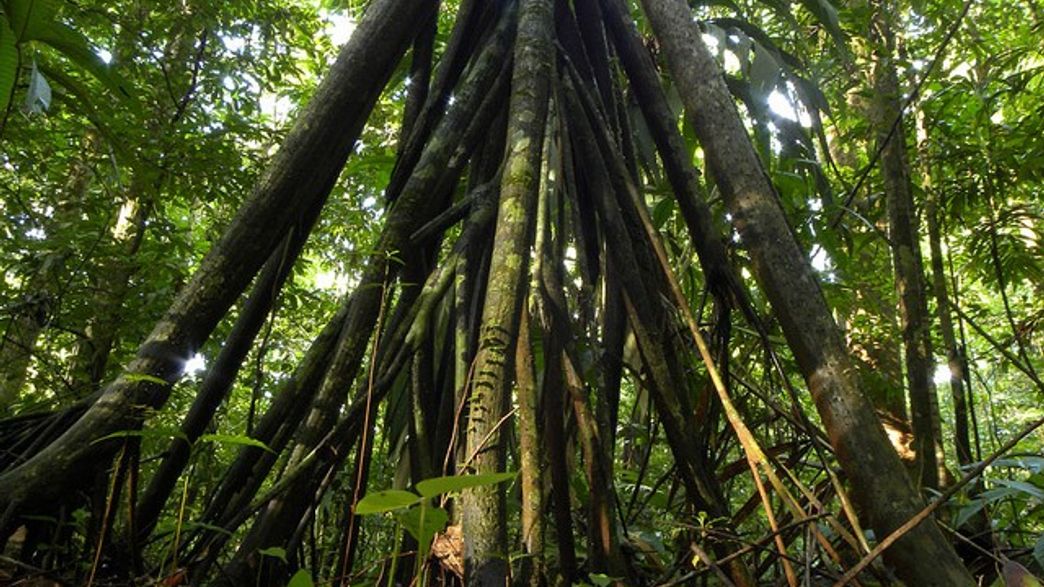We all know that trees are incredible living organisms. They remain connected, exchanging water and nutrients through their roots, and spending time in forests has been shown to improve both our physical and mental health. But have you ever heard of trees that can walk?
Yes, there is a type of palm in Ecuador that is said to “walk” up to 20 meters per year! This remarkable tree, scientifically known as Socratea exorrhiza, has sparked both local legends and scientific curiosity. In this article, we will delve into the intriguing concept of walking trees, explore the life of Socratea exorrhiza, and understand the science behind its alleged mobility.
The Legend of the Walking Palm
Local Lore and Mystical Beliefs
In the rainforests of Ecuador, the walking palm is surrounded by fascinating folklore. Locals believe that these trees can move to better positions to catch sunlight. This belief is rooted in the tree’s unique appearance; its stilt-like roots give the impression that it could simply pick up and move to a new location. These roots extend above ground, making the palm look like it is standing on stilts, ready to take a step at any moment.
Cultural Significance
The walking palm holds a special place in the culture and mythology of the indigenous people of the Amazon. It is often featured in stories and legends passed down through generations. These tales add to the mystique of the forest and highlight the deep connection between the people and their environment. The idea that trees could move to find better living conditions resonates with the human desire for adaptability and survival.
The Science Behind Socratea Exorrhiza
Understanding the Structure
Socratea exorrhiza, also known as the walking palm, belongs to the Arecaceae family. What sets this tree apart is its unique root system. Unlike most trees, which have roots that spread out underground, the walking palm’s roots are elongated and grow partially above ground. These roots can extend several meters from the base of the tree, providing stability in the soft, often waterlogged soil of the rainforest.
Adaptation to Environment
The above-ground roots of Socratea exorrhiza are believed to be an adaptation to its environment. In the dense and competitive rainforest, finding adequate sunlight can be a challenge. The walking palm’s roots allow it to thrive in unstable soil conditions and potentially reposition itself over time. This adaptation ensures that the tree can continue to grow and photosynthesize efficiently, even in the ever-changing conditions of the rainforest floor.
Scientific Explanations
While local legends suggest that the walking palm moves to find sunlight, scientists offer a more grounded explanation. Researchers believe that the tree’s unique root structure allows it to stabilize itself in the shifting soil of the rainforest. As the soil erodes or changes, the tree can produce new roots in different directions, giving the illusion of movement. This process is not a deliberate relocation but rather a natural response to environmental changes, ensuring the tree’s survival.
The Ecology of Walking Trees
Role in the Ecosystem
Walking palms play a significant role in their ecosystem. By stabilizing the soil, they help prevent erosion, which is crucial in maintaining the delicate balance of the rainforest. Additionally, their unique root systems provide habitats for various organisms, contributing to biodiversity. The presence of these trees can influence the composition of the forest floor, affecting everything from plant growth to animal behavior.
Interactions with Other Species
The walking palm interacts with numerous other species in the rainforest. Its roots can create microhabitats for insects, small animals, and other plants. These interactions highlight the interconnectedness of rainforest ecosystems, where each species, no matter how unique, contributes to the overall health and stability of the environment. The walking palm’s roots can also serve as a substrate for epiphytic plants, adding another layer of complexity to its ecological role.
Research and Discoveries
Ongoing Studies
Researchers continue to study Socratea exorrhiza to better understand its unique adaptations and ecological impact. Studies have focused on the tree’s root structure, growth patterns, and interactions with the environment. These investigations aim to uncover the mysteries of the walking palm and provide insights into the evolutionary pressures that shaped its development. By studying these trees, scientists hope to gain a broader understanding of how plants adapt to challenging environments.
Key Findings
One of the key findings in the study of walking palms is the understanding of their root dynamics. Scientists have discovered that the roots of Socratea exorrhiza grow continuously, allowing the tree to maintain stability and access nutrients in changing soil conditions. This growth pattern supports the idea that the tree’s “movement” is a natural adaptation rather than a conscious relocation. Additionally, research has shown that the tree’s roots can help improve soil health by aerating the ground and facilitating nutrient cycling.
Walking Trees in Popular Culture
Influence on Media and Art
The concept of walking trees has captured the imagination of many and has been featured in various forms of media and art. From fantasy novels to movies, the idea of mobile trees adds an element of mystery and wonder. These portrayals often draw on the real-life phenomena of trees like Socratea exorrhiza, blending scientific fact with creative storytelling. Walking trees have become a symbol of nature’s adaptability and resilience, inspiring artists and writers to explore the boundaries between reality and fantasy.
Educational Impact
Walking trees also serve as an educational tool to engage people in learning about botany and ecology. Their unique characteristics make them a fascinating subject for study, sparking interest in the natural world. Educational programs and documentaries often highlight the walking palm to illustrate the incredible diversity and adaptability of plant life. By learning about walking trees, people can gain a deeper appreciation for the complexities of ecosystems and the importance of conservation efforts.
The Broader Implications of Plant Movement
Understanding Plant Behavior
The study of walking trees contributes to the broader understanding of plant behavior and adaptability. While trees do not move in the same way animals do, their ability to respond to environmental changes challenges traditional views of plant life. Research into phenomena like the walking palm expands our knowledge of plant biology and highlights the sophisticated mechanisms plants use to survive and thrive. This understanding can inform agricultural practices, conservation strategies, and our overall appreciation of the natural world.
Future Research Directions
Future research on walking trees and similar phenomena may explore genetic and molecular mechanisms that enable such adaptations. Understanding how plants like Socratea exorrhiza modify their root structures in response to environmental pressures could lead to advancements in agriculture and forestry. These insights might help develop crops that are more resilient to changing climates or inform reforestation efforts in degraded landscapes. By continuing to study walking trees, scientists can uncover new strategies for addressing global challenges related to food security and environmental sustainability.
Conclusion
In exploring the concept of walking trees, we gain a deeper appreciation for the diversity and resilience of life on Earth. The walking palm, with its remarkable root structure and ecological significance, stands as a testament to the ingenuity of nature. As we continue to study and learn from these unique trees, we not only enrich our understanding of the natural world but also inspire efforts to protect and preserve the incredible diversity of life that inhabits our planet.







